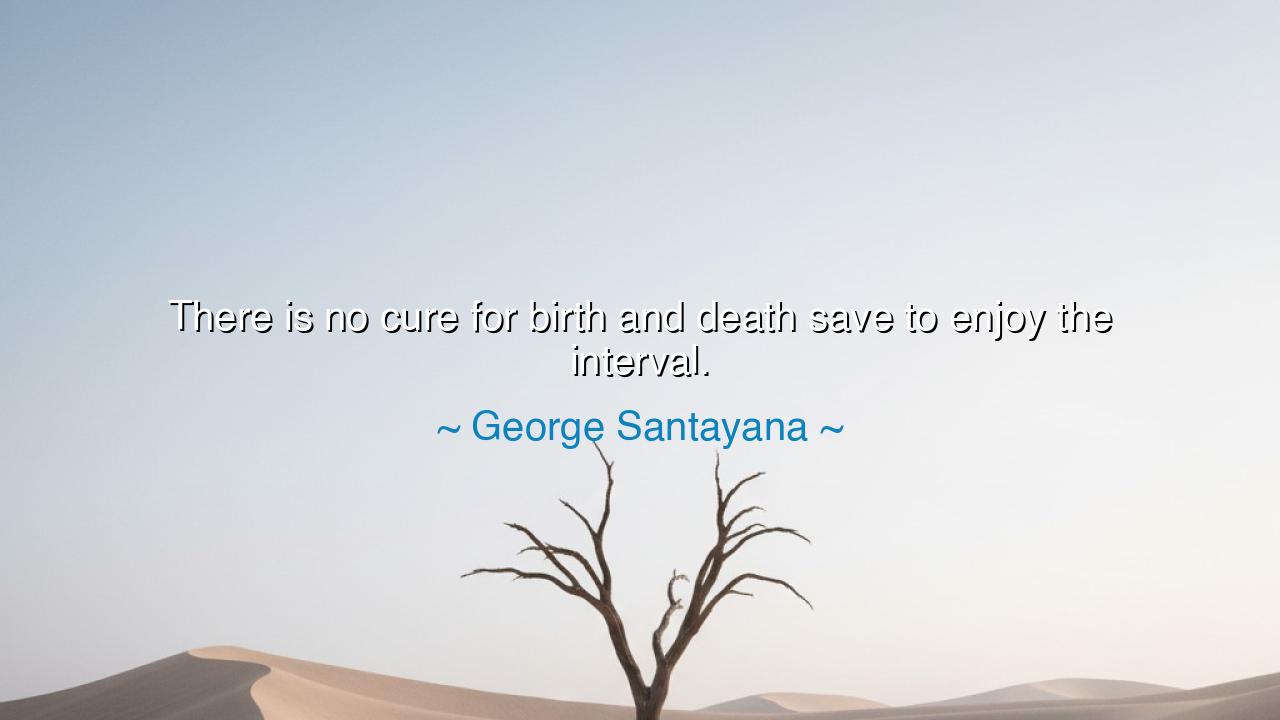
There is no cure for birth and death save to enjoy the interval.






“There is no cure for birth and death save to enjoy the interval.” Thus spoke George Santayana, the philosopher-poet of serene wisdom, who saw through the illusions of the world and yet loved it still. In these few words, he captures the entire cycle of existence—the coming into being, the inevitable passing away, and the brief, luminous space that lies between. His words remind us that life, fragile and fleeting as a flame, cannot be extended beyond its appointed span. Neither birth, that mysterious beginning, nor death, that unyielding end, may be escaped. What remains within our power, then, is only this: to enjoy the interval, to live with awareness, gratitude, and wonder during the short time granted to us beneath the sun.
Santayana, born in Spain and schooled in America, was a philosopher of reflection, not despair. He saw life as a journey through impermanence, yet never fell into the abyss of cynicism. To him, birth and death were not tragedies but the twin boundaries of the divine mystery—a rhythm of beginnings and endings that all must follow. In this rhythm, humanity’s task is not to seek a cure for what cannot be cured, but to live beautifully within the confines of fate. For what folly it is, he implies, to rage against the inevitable, when one might instead spend that energy in joy, in love, in creation. The interval—that is the realm of meaning. Between the silence that precedes and the silence that follows, there lies the music of being.
The ancients would have understood him well. The Stoics of old Rome—Marcus Aurelius, Seneca, Epictetus—taught that to live wisely is to accept what cannot be changed and to cultivate serenity amid uncertainty. They spoke of amor fati, the love of one’s fate, not as resignation but as harmony with nature’s design. In Santayana’s saying, that same philosophy is reborn in gentler tones. He tells us: the storm of life cannot be halted, the dawn cannot be prolonged. The wise man therefore learns not to seek escape, but to dance within the moment, to enjoy the fleeting passage that is his.
Consider the life of Leonardo da Vinci, that restless seeker of beauty and truth. He painted, invented, dreamed, and questioned until his final breath. Leonardo, knowing that death shadowed all men, did not waste his days in fear of it. Instead, he filled his interval with curiosity and creation. His notebooks, bursting with sketches and thoughts, testify that he sought not immortality, but fulfillment—the joy of understanding even a fragment of life’s vast design. When death came, it found him not defeated but complete, having spent his allotted interval in wonder. Thus, he embodied Santayana’s teaching: that the only true antidote to mortality is presence—to live fully, and to leave the world richer for one’s having lived.
The interval between birth and death is short, yet within it lie the entire realms of love, art, friendship, and discovery. To live it well is to master the highest art of all—the art of appreciation. But too often, humankind forgets this. We squander our days in worry for the future or regret for the past, mourning the brevity of life even as we let it slip away. Santayana’s wisdom calls us back to stillness, to remembrance of what truly matters. He urges us to look around and see the light falling upon the world, to taste the fruit, to hear the laughter, to breathe the air as though each breath were sacred. For the enjoyment of the interval is not hedonism—it is reverence for existence itself.
Yet enjoyment, in Santayana’s sense, is not always ease. It is also the capacity to find meaning in struggle, beauty in sorrow, and calm in the face of impermanence. The interval is not merely pleasure, but participation in life’s whole tapestry—the joys and the griefs, the triumphs and the failures. To live fully is to embrace all that comes, for each moment is a thread in the pattern that makes our existence whole. To flee from pain or fear of death is to live only half a life; to face them with courage and grace is to live as the ancients taught: nobly, wisely, completely.
So, my child, take this teaching to heart: You cannot escape birth, nor can you escape death—but you can shape the space between them. Do not seek cures for what cannot be cured. Instead, cultivate gratitude for what is. Fill your interval with learning, with kindness, with courage. Do not postpone joy until a perfect tomorrow, for tomorrow is not promised. Let every sunrise remind you that life itself is the rarest of gifts, and every sunset remind you that it is passing. When death finally comes, as it must, let it find you not yearning for more time, but grateful for the time you have had. For to have lived well—to have truly enjoyed the interval—is the one immortality that no death can erase.






AAdministratorAdministrator
Welcome, honored guests. Please leave a comment, we will respond soon